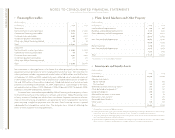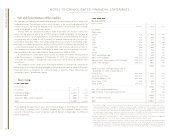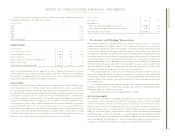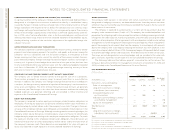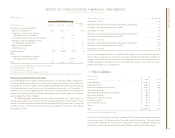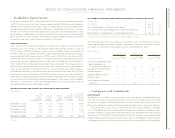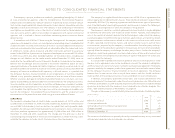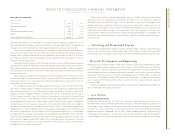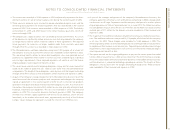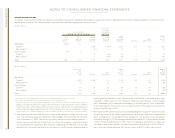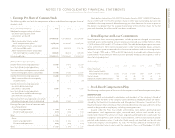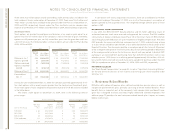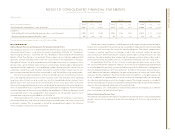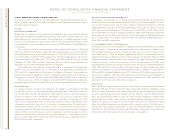IBM 2004 Annual Report Download - page 73
Download and view the complete annual report
Please find page 73 of the 2004 IBM annual report below. You can navigate through the pages in the report by either clicking on the pages listed below, or by using the keyword search tool below to find specific information within the annual report.
NOTES TO CONSOLIDATED FINANCIAL STATEMENTS
71
International Business Machines Corporation and Subsidiary Companies
ibm annual report 2004
The company is party to, or otherwise involved in, proceedings brought by U.S. federal
or state environmental agencies under the Comprehensive Environmental Response,
Compensation and Liability Act (“CERCLA”), known as “Superfund,” or laws similar to CERCLA.
Such statutes require potentially responsible parties to participate in remediation activities
regardless of fault or ownership of sites. The company is also conducting environmental
investigations or remediations at or in the vicinity of several current or former operating
sites pursuant to permits, administrative orders or agreements with state environmental
agencies, and is involved in lawsuits and claims concerning certain current or former
operating sites.
In accordance with SFAS No. 5, “Accounting for Contingencies,” the company records
a provision with respect to a claim, suit, investigation or proceeding when it is probable that
a liability has been incurred and the amount of the loss can reasonably be estimated. Any
provisions are reviewed at least quarterly and are adjusted to reflect the impact and status
of settlements, rulings, advice of counsel and other information pertinent to a particular
matter. Under SFAS No. 5, provisions for litigation-related expenses increased $125 million
in 2004 versus 2003. Any other recorded liabilities for the above items, including any
changes to such liabilities for the twelve months ended December 31, 2004, were not
material to the Consolidated Financial Statements. Based on its experience, the company
believes that the damage amounts claimed in the matters referred to above are not a
meaningful indicator of the potential liability. Litigation is inherently uncertain and it is not
possible to predict the ultimate outcome of the matters previously discussed. While the
company will continue to defend itself vigorously in all such matters, it is possible that
the company’s business, financial condition, results of operations, or cash flows could be
affected in any particular period by the resolution of one or more of these matters.
Whether any losses, damages or remedies finally determined in any such claim, suit, inves-
tigation or proceeding could reasonably have a material effect on the company’s business,
financial condition, results of operations, or cash flow will depend on a number of variables,
including the timing and amount of such losses or damages, the structure and type of any
such remedies, the significance of the impact any such losses, damages or remedies may
have on the company’s Consolidated Financial Statements, and the unique facts and
circumstances of the particular matter which may give rise to additional factors.
commitments
The company’s extended lines of credit include unused amounts of $2,714 million and
$2,208 million at December 31, 2004 and 2003, respectively. A portion of these amounts
was available to the company’s business partners to support their working capital needs.
In addition, the company committed to provide future financing to its clients in connection
with client purchase agreements for approximately $1,686 million and $763 million at
December 31, 2004 and 2003, respectively. The change over the prior year is due to
increased signings of long-term IT infrastructure arrangements in which financing is com-
mitted by the company to fund a client’s future purchases from the company.
The company has applied the disclosure provisions of FIN 45 to its agreements that
contain guarantee or indemnification clauses. These disclosure provisions expand those
required by SFAS No. 5, by requiring a guarantor to disclose certain types of guarantees,
even if the likelihood of requiring the guarantor’s performance is remote. The following is
a description of arrangements in which the company is the guarantor.
The company is a party to a variety of agreements pursuant to which it may be obligated
to indemnify the other party with respect to certain matters. Typically, these obligations
arise in the context of contracts entered into by the company, under which the company
customarily agrees to hold the other party harmless against losses arising from a breach
of representations and covenants related to such matters as title to assets sold, certain
IP rights, specified environmental matters, and certain income taxes. In each of these
circumstances, payment by the company is conditioned on the other party making a
claim pursuant to the procedures specified in the particular contract, which procedures
typically allow the company to challenge the other party’s claims. Further, the company’s
obligations under these agreements may be limited in terms of time and/or amount, and
in some instances, the company may have recourse against third parties for certain pay-
ments made by the company.
It is not possible to predict the maximum potential amount of future payments under
these or similar agreements due to the conditional nature of the company’s obligations
and the unique facts and circumstances involved in each particular agreement. Historically,
payments made by the company under these agreements have not had a material effect
on the company’s business, financial condition or results of operations. The company
believes that if it were to incur a loss in any of these matters, such loss should not have a
material effect on the company’s business, financial condition or results of operations.
In addition, the company guarantees certain loans and financial commitments. The
maximum potential future payment under these financial guarantees was $58 million and
$74 million at December 31, 2004 and 2003, respectively. These amounts include the limited
guarantee associated with the company’s loans receivable securitization program. See
note j, “Sale and Securitization of Receivables,” on page 64.
Changes in the company’s warranty liability balance are illustrated in the following table:
(Dollars in millions)
2004 2003
Balance at January 1 $«780 $«614
Current period accruals 924 971
Accrual adjustments to reflect actual experience 42 65
Charges incurred (802) (870)
Balance at December 31 $«944 $«780
The increase in the balance was primarily driven by increased warranty activity associated
with personal computers due to increased sales volumes.



